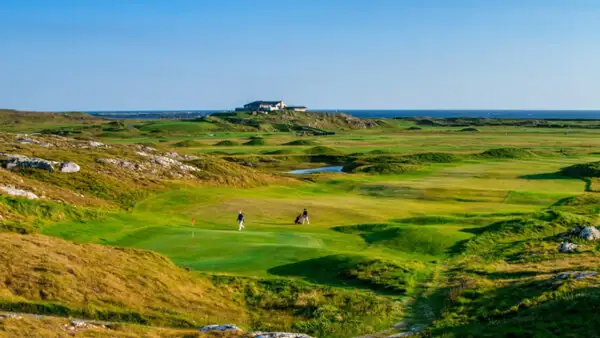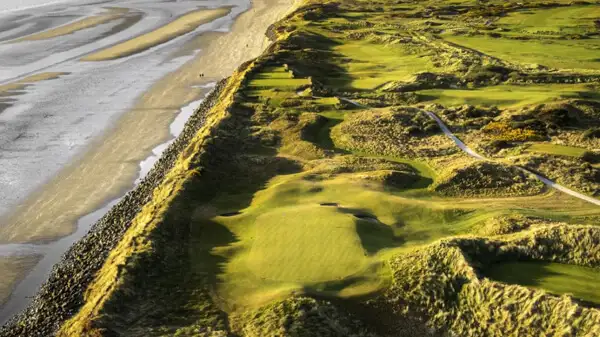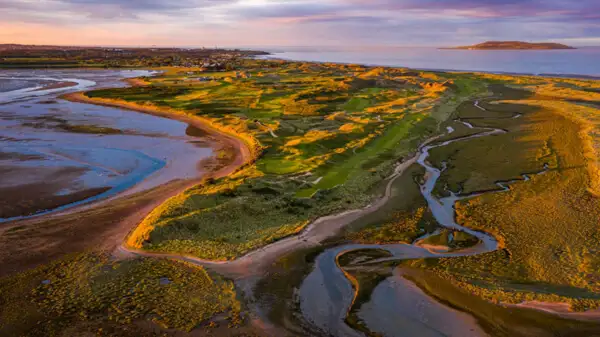There are about 247 Links Courses in the world. As many as 211 of them are in the British Isles, including Ireland. On the island of Ireland you will find 58 links courses, which is about a quarter of all links courses worldwide!
Page Contents (click line to jump the text)

Intro
So if you want to play one or more links courses on your golf holiday, Ireland is the place to be!
When my wife and I were getting our golf license, the more experienced club golfers were always telling us about links courses and their holidays in England or Scotland. “Playing in a stiff breeze right by the sea, overlooking miles of sandy beaches, the taste of salt in the air – the fairway stretches narrowly through undulating dunes and the greens are many faster than back home….”
With shining eyes they told us and after playing some links courses in Scotland and Ireland we can relate to this enthusiasm. We have been living in Ireland (second home) for a few years now. We have also played several golf courses in Ireland and know the island and the climate very well.
But I admit that I first had to learn links courses to appreciate them. Because I didn’t get along with the conditions at all in the beginning. The German inland golf courses or parkland courses play quite differently!
Why that is and what tips will help you on the links course is what this article is about.
What are Links Courses?
In the British Isles and Ireland, left-hand traffic is the rule. But that is not the reason why Links Courses are called that. Rather, the name is derived from the English “link”, which roughly translates as “connection”.
As golf became more popular in the 19th century, many courses were built into the dune landscapes connecting the fertile farmland with the coast. This salty-sandy intermediate or “connecting” land was relatively barren and therefore less valuable to farmers. Since golf courses require a lot of space, they could acquire this land more easily and cheaply than pasture or farmland.
A links course is therefore always situated by the sea and is often embedded in the sand dunes in front of the beach. The classic links courses were laid out without any mechanical help, i.e. with shovels and wheelbarrows.
Therefore, they follow the local conditions and the landscape was only minimally changed. Classic links courses are therefore particularly natural golf courses that blend very harmoniously into the landscape.

What conditions can golfers expect on a links course?
Since links courses were often built into the dunes in front of the beach, they are usually undulating and hilly. The fairway practically follows the dune valleys. The fairway itself also tends to be undulating and sometimes quite narrow.
Overall, however, links courses are rather flat. There are no mountains, only dunes, waves and humps. So the metres in altitude you have to walk on your round are limited.
There are few or no trees on Links Courses. This means that you usually have a very clear view of the course when you are standing on a hill.
Links courses are usually built into a very sandy landscape. This means that the soil does not store much water. In summer, the grass quickly turns brown and the grass on the fairways and greens becomes very short. The ground may then become very hard and the divots very shallow.
When the ground is hard and the grass is short and dry, the fairways and greens become very fast. The ball rolls forever and stops badly.
In the winter months, a little more moisture moves into the sandy soil, the grass becomes greener, the fairways and greens become a little softer and the conditions become easier! Most links courses on the island of Ireland do not get frost at all in winter and are playable all year round.
Because links courses are built into the sandy landscape or even into sand dunes, it is naturally easy to create sand bunkers. The bunkers can then be very deep and soft.
Finally, the obvious: Links courses are practically always windy! Sometimes very very windy! Since they are located directly on the sea and offer hardly any wind protection, you are at the mercy of sun, wind and rain.
On the other hand, you always have beautiful views of the coast and the sea – that’s how a holiday should be!
How can the golfer adjust to the links course?
Having looked at the conditions on the links course, let’s take a look at how best to adjust to play the links course successfully and enjoy it to the maximum.
Two things are extremely important:
- it is windy or very windy and
- the ground is quite hard and fast or very fast.
And with these tips you can prepare yourself well for this:
Tips for the drive
On our home greens, you usually want to create a lot of spin on the drive to get the ball well in the air, because when the ball lands, it doesn’t roll very far – right? On the links course you have to pay much more attention to the wind direction: If the wind comes from behind, you can tee off as usual.
But if the wind comes from the side or from the front, you should keep the ball flat so that it is less caught and deflected by the wind. But don’t worry about losing distance: when the ball lands on the fairway, it usually rolls much further than usual because the ground is harder.
How do you keep the ball flat when teeing off? The draw is better than the slice. If you put the tee in a little higher, position the ball a little more to the left and make sure you swing flat, the ball will stay flatter. Take a little speed out of it, think more like a three-quarter swing so you don’t create too much spin.
When you tee off with the iron, take a longer iron and make a three-quarter swing. Think more about rolling far than flying far.

Tips for the fairway
On the fairway, too, you usually want to stay under the wind. The iron punch shot helps: The ball lies a little more centrally between your feet, so the iron hits it a little earlier.
To avoid a slice, you have to close the club face a little more. Then make a rather flat shot by lowering the right shoulder a little (right-handed players) and keeping the left shoulder well in the follow-through. Make only a half or three-quarter shot, then the ball flies flatter and is easier to control.
My biggest problem on the fairways was hitting too steep and then bouncing hard off the ground. Remember to “tee it flat” and “draw” and it will go better.
Always remember that the ball stops worse and rolls out longer – then where does it roll to? Exactly! Learn to make the roll out work for you and you will make up for the loss of distance on the shot.
Tips for pitching
The ball is likely to stop badly and roll out longer. It is also not always easy to hit a deep divot into the hard ground. Open up the clubface a bit for a little more loft and hit flatter so the sole of the club slides flat through the turf without going too deep.
Strong wind from behind carries the ball much further. Strong wind from the front stops the ball very quickly. Crosswind – you can imagine it now. Plan for the wind and leave more room to roll out.
Tips for chipping
On hard ground with short grass, a long chip with a long roll out is often better than a high pitch because you can stay under the wind. From the front green you can often make a long putt – as always, just swing through a bit more.
Otherwise, I would use a slightly longer club for chipping so that the ball doesn’t fly much and rolls out rather long.

Tips for the deep sand bunker
Sand bunkers on links courses can be very deep, with fine, dry powder sand. The green behind is then very fast again. So you want to let the ball fly out of the deep sand short and high so that it doesn’t roll out too far.
To do this, open the club face of your sand wedge considerably and make sure that the club face remains as open as possible in the follow-through, i.e. that it does not close too early. Strike the ball steeply and turn your upper body very actively, but keep your wrists stable (stiff). Now the only thing that helps is speed: hit the ball full so that you also hit through the deep sand!
The ball should be “catapulted” briefly out of the bunker.
Tips for the green
The greens on links courses are often very fast and have lots of undulations and dents. The only thing that helps is practice: Go to the practice green and try it out so that you learn to judge speed and direction. You will have to adjust your feeling.
In addition, a strong wind can “shake” a smooth putt. Position yourself wider than usual, lower your centre of gravity, bring your arms and hands close to your body and make sure you have a stable stance and a smooth, even movement.
The wind can also deflect, lengthen or shorten your ball when putting – so pay attention to the wind direction and strength when putting.
Finally
Did all that sound complicated? Don’t worry, you’ll get used to it quickly. Practice flat strokes, half strokes and three-quarter strokes at home and you’ll be well prepared.
The wind is your new friend, it plays with you and you get to play with it! Nowhere else do you play so directly with the elements as on a links course!
Enjoy the unobstructed view, the beautiful sea vistas and the fresh salty air – rejoice in the dunes, the seagulls and the wind!
So let’s go to Ireland – to golf on one of the top several links courses!
More interesting articles for you
9 GREAT GOLF LINKS COURSES IN NORTHERN IRELAND
GOLF HOLIDAYS IN THE “GARDEN” OF WICKLOW, AND THE SUNNY SOUTH EAST OF IRELAND
GOLF ON THE DOORSTEP – 7 EXCITING GOLF COURSES AROUND DUBLIN
11 GREAT GOLF COURSES ON THE SOUTHERN WILD ATLANTIC WAY
Cover photo credit: Photo by Cristina Glebova on Unsplash